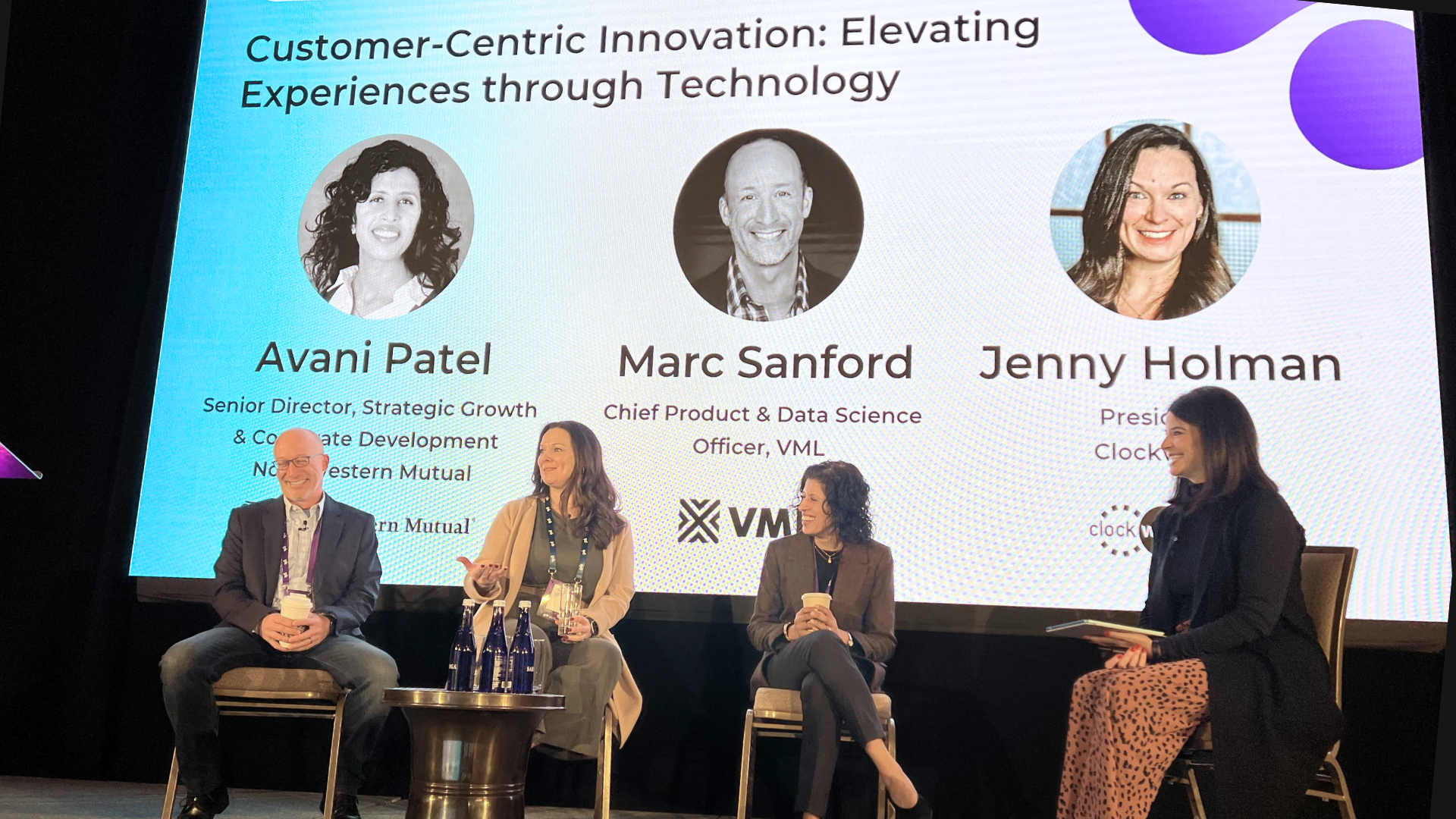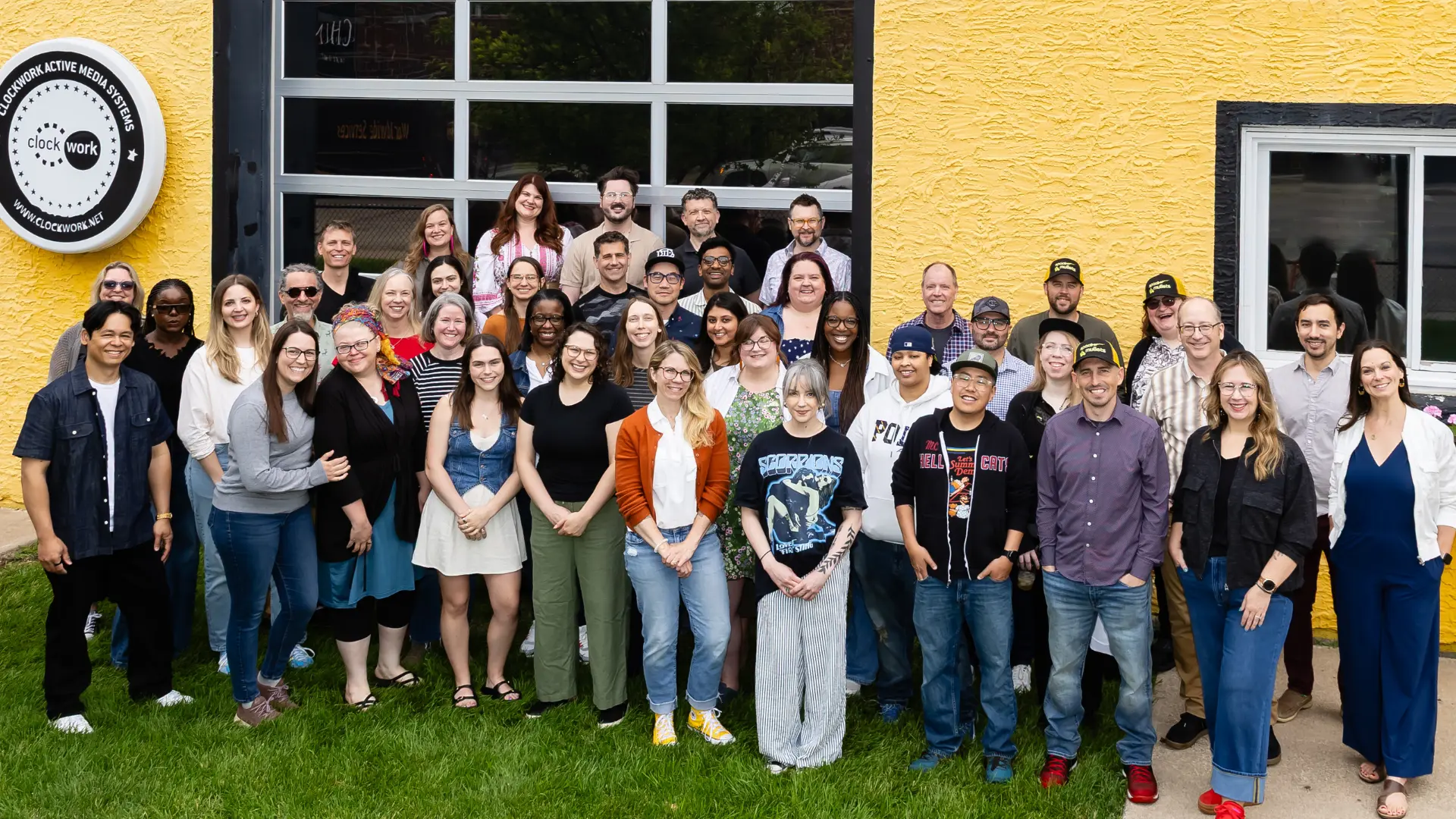I had the pleasure of speaking on a panel about Customer-centric innovation – Elevating experience through technology at the GDS Digital Innovation Summit in Boston. As expected, AI, data governance, and digital customer experience innovation were focal points of nearly every conversation with leaders attending from financial services, healthcare, insurance, telecommunications, and manufacturing organizations. What struck me most was how different each organization is and yet how similar they are in searching for solutions to the same challenges, regardless of industry.
Many are moving quickly to identify opportunities for AI to build efficiency and drive impact to the bottom line. Discussions often focused on data governance, ethical use, and gaining and maintaining consumer trust. From our experience at Clockwork, we’ve seen the newest innovations quickly become “the tail wagging the dog”. The drive to be an early adopter overpowers understanding why we’re implementing a new technology and the outcomes we expect to see from it.
If you know Clockwork, you know we approach client opportunities with a mindset of People, Process, and (then) Technology. This approach ensures we’re building the right thing and bringing the people involved along with us. It also ensures we’re taking a focused look at existing processes to identify necessary changes to reduce friction and enable efficiency. Without this intentional mindset, we’ll likely turn to AI to automate broken or antiquated processes, finding efficiency but masking an opportunity to make significant improvements.
Here are important takeaways leaders from every industry should consider as part of their customer-centric innovation:
- The critical link between employee and customer experience
- How to make nebulous strategies actionable
- Ways to fail-proof your customer experience strategy
The critical link between employee and customer experience
Imagine a theater production. The audience’s experience is shaped not just by the actors on stage but the efforts and coordination of everyone working behind the scenes. This analogy rings true for customer experience, emphasizing the interconnectedness of the front and the back of the house. By using this lens, we’re able to identify friction points ripe for customer-centric innovation.
Mapping the customer journey
Just as a director maps out a play, we map the customer journey, aligning it with the employee experience. This mapping isn’t just a task; it’s a strategic tool that sheds light on priority opportunities and pain points. It’s about seeing the whole picture — not just the individual scenes but how they connect.
Creating a service blueprint
Think of this as the script and stage directions for our play. It details every touchpoint and behind-the-scenes action, ensuring that the performance is seamless when the curtain rises. This blueprint isn’t just for the customer; it’s a critical guide for our employees, showing them how their roles contribute to the overall experience.
Engaging employees from the start
Here’s where the magic of theater comes into play. By involving our employees from the outset — in the mapping, the planning, the rehearsals — we’re not just telling them about the changes; we’re inviting them to be part of the creation process. This early engagement is crucial for fostering a deep connection with the change process.
The power of change enablement
Bringing employees along from the beginning isn’t just about getting buy-in; it’s about empowering them to be active participants in the transformation. This approach demystifies the process, reduces resistance, and builds a coalition of change champions. It’s like turning our employees into co-directors of the play, each with a vested interest in its success.
Transitioning from awareness to commitment
Early engagement means that employees understand the “why” behind the changes and are more quickly committed to their roles in this new production. They see the benefits to the customers, to themselves, and to the organization. It’s about moving from reading the script to living it out on stage.
The outcome — a dynamic, responsive organization
This approach doesn’t just lead to change; it leads to sustainable innovation. It ensures that the changes we implement are embraced and that our organization remains agile, responsive, and, above all, customer-centric.
Making nebulous strategies actionable
Our clients often come to us with detailed strategies from top consulting firms, filled with innovative ideas like digital twins, AI-enabled digital experience platforms (DXPs), or content supply chain evolution, but unsure how to make them a reality.
How do we make these strategies actionable? We take these extensive playbooks, pinpoint where to start, and turn those ideas into reality. We’re the bridge from strategic vision to practical implementation. So, how are we testing innovation and the impact of change?
Starting with a hypothesis
We dig in by exploring the customer journey and service blueprint. And, like scientists, we identify hypotheses about what might improve our customer’s experience or operational efficiency. This is our starting point for innovation—a clear, testable statement that predicts an outcome based on a specific change or introduction of a new idea.
Building prototypes
Next, we bring those hypotheses to life through rapid prototypes. They allow us to explore our ideas in the real world in a scaled-down, controllable manner. This step is crucial for gathering initial feedback and making necessary adjustments.
Employing continuous development
Our approach is agile at its core. This means we’re not just testing in isolated bursts, but continuously. Each cycle of feedback and iteration brings us closer to a solution that truly resonates with users. It’s about being flexible and responsive, not wedded to our first ideas.
Leveraging data analytics and user feedback
We ground every decision in data, using analytics to understand user interactions with our innovations, identifying what resonates and what needs refinement. Coupled with direct user feedback through methods like focus groups and beta testing, this approach ensures our solutions are not only data-driven but deeply aligned with actual user needs and preferences.
Iterative development and rapid prototyping
Our mantra is “fail fast, learn faster.” By rapidly prototyping and testing, we quickly learn what doesn’t work, allowing us to pivot and refine our approach. This iterative cycle is key to developing solutions that are both innovative and practical.
Cross-functional team collaboration
Innovation testing isn’t siloed. We bring together minds from across the company—designers, engineers, marketers, and beyond—to look at challenges from every angle. This diversity of thought ensures our solutions are well-rounded and impactful.
Real-world piloting
Before a full rollout, we pilot our innovations in real-world settings. This is the dress rehearsal before opening night. It gives us a glimpse of how our solution performs under actual conditions and provides a final checkpoint for refinement.
Scaling and evaluation
Successful pilots lead to scaling, but our evaluation doesn’t stop there. We continuously monitor performance, user satisfaction, and return on investment to ensure our innovations deliver sustained value.
Fail-proofing customer experience strategies
As we navigate the future of customer experience (CX) in an era marked by rapid technological advancements, particularly in artificial intelligence (AI), the imperative to keep the customer at the core of all solutions becomes even more pronounced. The evolution of CX is not just about leveraging new technologies but about deepening our understanding of customer personas, journeys, and the shifting landscape of their needs and pain points. Here’s how businesses can ensure their customer-centric strategies remain adaptable and relevant:
Continuously update customer insights
It’s crucial for businesses to regularly refresh their understanding of customer personas and journeys. This involves actively monitoring and analyzing how customer expectations and behaviors change, especially in response to new technological possibilities.
Maintain customer centricity amidst AI advancements
AI offers unprecedented opportunities for personalization and efficiency. However, businesses must ensure that AI and other technologies are used to enhance customer-centric solutions rather than letting the capabilities and potential of AI dictate the direction of strategies. The customer’s needs and experiences should always drive innovation, ensuring that technology serves to enrich, rather than overshadow, the human aspect of CX.
Identify evolving pain points and opportunities
Staying ahead requires a proactive approach to identifying new customer challenges and opportunities. This means leveraging data analytics and AI to gain insights, but doing so with the aim of better serving the customer, addressing their pain points, and enhancing their overall experience with more personalized and relevant solutions.
Foster agility in strategy adaptation
Adopting flexible and iterative methodologies in strategy development allows businesses to quickly pivot in response to new customer insights or technological advancements. This agility is essential in maintaining relevance and delivering experiences that resonate with customers on a deeper level.
Embrace ethical data use and privacy
As strategies become increasingly data-driven, maintaining a commitment to ethical data practices and prioritizing customer privacy is vital. Transparent handling of customer data not only complies with regulatory standards but also builds trust, reinforcing the customer-centric values of the business.
Incorporating these considerations ensures that businesses not only adapt to the technological landscape but do so in a way that consistently places people at the center of their strategies. By doing this, companies can navigate the disruptions and opportunities presented by AI and other technologies, ensuring that customer-centricity remains the guiding principle in the evolution of CX.




